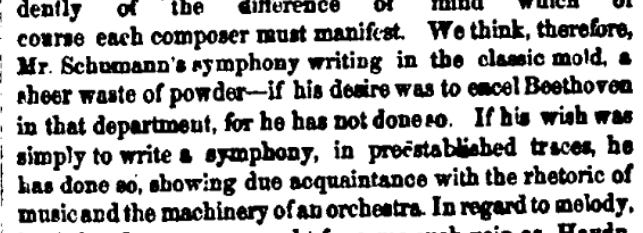If I had to summarize my research in one sentence, I reconsider musicians who other scholars and writers chose to write out of classical music history. Who were these musicians? What did they accomplish? Why did they “disappear”?
The impulse to answer these questions drove my recent story for the New York Times on William Henry Fry’s 1853 piece called Santa Claus: Christmas Symphony.
My “hook” for the story was the New York Philharmonic’s ambitious Project 19, an initiative designed to highlight women composers, especially by commissioning new works. It may not be obvious on the surface, but these topics go hand-in-hand.
Two complementary arguments shape the article :
The US classical music industry has always found ways to close ranks and exclude the musicians it found unacceptable or unworthy.
The patterns of exclusion have remained remarkably persistent.
#1 is obvious given how exclusionary the industry still is. Prevailing attitudes in the eighteenth and nineteenth centuries dehumanized or objectified anyone who wasn’t a man of white European ancestry, and we shouldn’t expect that the classical music industry would have developed in a different direction. Surprise: It didn’t!
As I studied this era of American music history in graduate school, though, I was surprised to learn that the industry used a diverse array of strategies for excluding white American male composers, too—people we might assume would have been part of the industry’s most privileged class. This is where #2 comes into play.
My book Orchestrating the Nation goes into these strategies at length, and the epilogue starts to make connections to race, gender, and other social categories that have remained underrepresented on the concert stage despite a changing social landscape.
So what does Santa Claus have to do with any of this? Strap in and find out!

Hiding in Plain Sight
My Times draft was a hair too long, so we cut a section that elaborated on a common form of exclusion in classical music that goes beyond blatant inequity:
The sublimation of personal prejudice into aesthetic dismissal.
This phenomenon happens when someone attempts to cover up personal bigotry toward a group of people by arbitrarily dismissing their work as musically unworthy.
In the context of composition, these types of dismissals come in one of two packages:
The Double Standard - When composers of one demographic are praised/welcomed for using certain stylistic techniques while composers of other demographics are dismissed/excluded for using the same techniques.
The Moving Goalpost - A composer’s attempts to move away from or to maintain white European masculine norms are dismissed as inferior.
Hopefully we all recognize the concept of a double standard. The moving goalpost may be less familiar, though, because it can be hard to spot. But we can be sure it has a tangible effect on the real people it’s meant to diminish.
Here’s a crystal clear example from a passage in the Pittsburgh Courier written by William Grant Still in 1950:
There is resentment against a Negro composer who doggedly insists that he [sic] can and will write abstract music of a non-racial nature. At the same time, if the Negro composer writes racial music, his opponents will say [white composers] John Powell and George Gershwin did it better!
Sarah Kirkland Snider, one of the composers I talk about in the Times, has also explained how people have used similar strategies against her:
One teacher, critiquing an orchestra piece of mine, leaped from side to side in front of the (all male but me) class, assuming mock-Victorian pearl-clutching-and-fainting poses to pantomime his perception of the music’s interior monologue as it moved from phrase to phrase: “Oh! I’m so sad! But, but now…now I’m…happy! But wait, now—now—I’m…sad again. Oh boohoohoohoo!”
Aesthetic dismissal has remained a common tool for “sublimating” prejudice because it gives deeply bigoted people plausible deniability. “Oh, I’m not racist. This piece just isn’t good music.” (Though in Snider’s case, exploiting the gendered stereotype of feminine emotionalism betrayed the person’s sexist attitudes.)
Sadly, I think this form of discrimination is one of the least understood (and least acknowledged) aspects of our field precisely because it’s meant to hide personal prejudice. “Discriminating taste” is presumed to be integral to the classical music enterprise—what else makes it “classical,” after all?
In fact, I can’t begin to count how often I’ve heard people ask, “How is the industry prejudicial if it just so happened that white men wrote the best music?” Well, as I’ve written before, it didn’t just happen. A collection of activities created a closed system, and a complementary set of activities simultaneously defended it.
William Henry Fry’s Santa Claus stood at the center of this process in the early 1850s.

What is Absolute Music?
Classical music culture became so stuffy and prejudicial in the first place in sync with the ideology of absolute music.
Most classical musicians probably recognize the phrase “absolute music” from their undergraduate days. But what is it exactly?
In casual conversation, we use it to describe a piece of instrumental music with a nondescript title—Symphony No. 3 in B-flat Major, for example.
But isn’t a piece like this just music? Why the separate name?
Well, we have Richard Wagner to thank for that.

As musicologist Sanna Pederson has explained, Wagner coined the term “absolute music” in 1846 to refer to instrumental music with nondescript titles—just as you might think. But his underlying purpose was to designate this music as politically irrelevant, and he needed a way to categorize it. Voilà! New phrase.
Wagner, in fact, thought abstract instrumental music should fade into the past for good because it reflected outdated political values. It’s noteworthy, then, that he first used the phrase “absolute music” in a commentary on Beethoven’s Ninth Symphony. He thought Beethoven’s use of voices in the finale pointed a way forward toward a new politically relevant music.
Beethoven’s Ninth certainly was politically relevant in the 1840s. As musicologist Mark Evan Bonds has shown, performances of the piece became pretexts for political gatherings in the German-speaking lands, where large assembles of people were otherwise restricted by law. (Remember the First Amendment? It was radical in the 1780s because free assembly was not the norm in many Western European countries!)
Wagner wanted music that would be even more political than Beethoven’s Ninth. He called this genre the “music drama.” His writings from the period 1849–51, such as Art and Revolution, The Artwork of the Future, and Opera and Drama, explained his political vision and how his “music drama” concept would fit into it.
For all the revolutionary talk, though, aspects of Wagner’s thinking were very old. To reference Bonds again: the idea that music should be actively involved in political life dates all the way back to Plato, if not earlier. (Think Orpheus myth!)
So if Wagner was trying to reclaim music’s political value in 1846, there must have been people who were trying to take music out of politics. Who were they?

It’s All Political
“GIMME SOME OF THAT SANTA ENERGY!” OK, OK — I hear you. I’ll get there.
At this point, I imagine that parts of this story are very familiar to you. We all know about the Wagner–Brahms conflict. But we typically learn what happened after Wagner expressed these “revolutionary” ideas, not what prompted them.
To start, we have people like E.T.A. Hoffmann, who wrote in 1810 that anything other than instrumental music with a nondescript title is garbage. No, literally—he wrote that instrumental music that tells a story or paints a picture should be “banished into oblivion”! He was specifically referring to works with obvious political resonance like Paul Wranitzky’s “Peace” symphony from 1797 (Op. 31).
Hoffmann’s position was a pretty unusual take, because even pieces that didn’t openly tell a story still used the musical language of those that did. A piece called Symphony in D Major that sounds like a battle symphony is clearly meant to evoke a battle. (You can read my colleague Melanie Lowe’s book for more information on that phenomenon!)
Over time, though, a lot of critics joined Hoffmann in his elevation of abstract music.
Now, let’s move to the USA —
Critic John Sullivan Dwight of Boston had just heard some instrumental music that told a political story, and this is what he wrote in response:
We are sorry to see such circumstances dragged into music as the “Indian War Council,” the “Advance of the Americans,” the “Skirmish,” and “Fall of Tecumseh,” … Music, aiming at no subject,—music composed with no consciousness of anything in the world but music, is sure to tell of greater things than these.
Music aiming at no subject? What’s that? That’s right: Absolute music!
Now guess when Dwight wrote this. . . keep guessing . . . 1846!
The term “absolute music” obviously wasn’t in common circulation yet, so Dwight used phrases that essentially meant the same thing.
Now, to be clear—I’m not bringing up this coincidental date to say that Wagner came up with the phrase “absolute music” as a direct response to Dwight.
I’m showing that debates about political music (Wagner) and apolitical music (Hoffmann/Dwight) had been developing for a couple of decades when Wagner finally had enough and said, “LOOK — this older instrumental stuff is crap. It’s not political. It’s merely absolute music. We need something revolutionary!”
Guess who had moved to Paris in 1846 and stayed there until 1852, soaking up all of this European political stuff? William Henry Fry, composer of Santa Claus.

Recap with Timeline
Ancient Greece to early 1800s — people tended to believe music is political
Early 1800s to 1840s — a few people like Hoffmann and Dwight start trying to remove music from politics
1846–51 — Wagner reclaims music as a political art and sets up dichotomy between “music drama” (political/good) and “absolute music” (apolitical/bad)
1846–52 — William Henry Fry is in Paris soaking it all in
Fry’s Politics
Like Wagner, William Henry Fry was a devoted political thinker. He started his career as a writer for newspapers in Philadelphia and then moved to Paris in 1846 to be a correspondent for the Public Ledger. His political commentary caught the eye of Horace Greeley, editor of the New York Tribune, the country’s leading Whig newspaper.
If you’ve forgotten your US political history and have no idea who the Whigs were, that’s OK. Just like today’s political parties, they were a loose coalition of people with diverse ideas. But they’re an important part of this story because Greeley helped contribute to the breakup of the Whig Party in the early 1850s as he opposed slavery and favored certain types of democratic socialism. (Karl Marx was a contributor to the Tribune throughout the 1850s!) He then helped found the Republican Party, which eventually elected Abraham Lincoln to the presidency in 1860.
Cool story, Teen Jeopardy! So what?
Fry began contributing to the Tribune from Paris in 1849 and wrote a prodigious number of letters that outlined his political and musical philosophies. In a nutshell, he thought that music by Haydn, Mozart, and Beethoven was stuck in the past. For him, it crystallized the Old World political order—aristocracy and oppression—that US democracy was supposed to be fighting in a clash of ideologies:
I see no hope for Art, but in the extinction of the principle of Force and Privilege, and the substitution of its attractions in their stead.
Like Wagner, he wanted to create a musical future intertwined with progressive politics—but with an American spin, of course.
[Quick pause to point out that when I was a graduate student, I read hundreds of issues of the New York Tribune on microfilm just so I could identify Fry’s articles, many of which were unsigned. I made a giant spreadsheet that I later used in my dissertation and book. Now all it’s all online. Go figure!]
Santa Claus is Comin’ To Town
Fry came back to the United States in 1852, settled in New York, and stumbled on a big kerfuffle involving the New York Philharmonic. For the past several years, the orchestra had been refusing to perform music by American composers despite an article in the by-laws saying they should:

(From the by-laws, available at the New York Philharmonic Digital Archives)
This is the point in the story where my article for the Times picks up.
By this point, Fry had taken a position at the Tribune as political editor and—you’ll love this—as music critic. As soon as he gets wind of the Philharmonic brouhaha, he gets really fired up and prints some sick burns like this:
If it be an almighty fiat that nobody here, native or naturalized, can write a piece of music as poor as Mendelssohn’s “Happy Voyage,” then the cause of music is hopeless in this country, and the sooner the Philharmonic Society shuts up the better.
Basically, if the Philharmonic is going to play the dregs of European composers, Americans don’t stand a chance even if their music is the best thing since sliced bread. I’d be upset too! But here’s the kicker: Fry was also using his space in the Tribune to rail on European composers who weren’t writing in progressive styles.
Here’s a sampling of his review of Schumann’s Second Symphony, which the Philharmonic performed literally a week before Fry blew up about Santa Claus:

(“I’m progressive—new wine in new wine skins and all that!”)

(“If Schumann wanted to write a symphony, he did. If he wanted to write a better symphony than Beethoven, he did not.” Ouch!)

(“This is a piece of absolute music.”)
These last couple of sentences are truly incredible. Fry sets up a dichotomy between music that is “simply symphonic” and music that is “descriptive, dramatically”—the very split between sides of the emerging European debate.
His wording here is not Wagner’s, but it’s clear that he’s talking about “absolute music” and something else. But he wasn’t talking about Wagner’s “music dramas.” He was talking about Santa Claus.
A Cliffhanger, Really?
There is So. Much. More. to the Santa Claus story.
My piece in the Times focused on a conflict about diversity of representation on the concert stage. Here I’ve introduced the aesthetic dimension of the conflict.
Trust me—it’s all going to come together in the end!
(But will there be presents?)
Until next time…

Music City Spotlight: Our local classical station, 91 Classical, is running its second annual Student Composer Fellowship Program this fall. I’d love to see similar programs take shape in cities all around the country.
In the queue: “What’s Santa Got To Do With It,” Part 2
Content fueled by Badbeard’s Microroastery (Portland, OR).
If you like what you read here:



